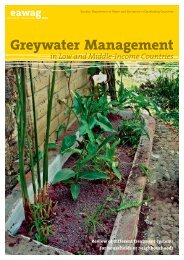Household Water Treatment and Safe Storage Factsheet: Source ...
Household Water Treatment and Safe Storage Factsheet: Source ...
Household Water Treatment and Safe Storage Factsheet: Source ...
Create successful ePaper yourself
Turn your PDF publications into a flip-book with our unique Google optimized e-Paper software.
<strong>Household</strong> <strong>Water</strong> <strong>Treatment</strong> <strong>and</strong> <strong>Safe</strong> <strong>Storage</strong><br />
Fact Sheet: P&G Purifier of <strong>Water</strong><br />
(formerly known as PUR)<br />
The <strong>Treatment</strong> Process<br />
Potential <strong>Treatment</strong> Capacity<br />
Very Effective For: Somewhat Effective For: Not Effective For:<br />
Bacteria<br />
Viruses<br />
Protozoa (including<br />
Cryptosporidium <strong>and</strong> Giardia)<br />
Helminths<br />
Arsenic<br />
Turbidity <strong>and</strong> some organic<br />
matter<br />
Some heavy metals (e.g.<br />
chromium, lead)<br />
Some chemicals <strong>and</strong> pesticides<br />
Taste, odour, colour<br />
Salt<br />
Fluoride<br />
Nitrate<br />
What is P&G Purifier of <strong>Water</strong>?<br />
The P&G Purifier of <strong>Water</strong> (formerly known<br />
as PUR) is a combined flocculentdisinfectant.<br />
The Purifier of <strong>Water</strong> packet<br />
was developed by Procter & Gamble (P&G)<br />
in collaboration with the U.S. Centers for<br />
Disease Control <strong>and</strong> Prevention (CDC) to<br />
replicate the community water treatment<br />
process at the household level.<br />
Purifier of <strong>Water</strong> is a powder which contains<br />
both coagulants <strong>and</strong> a timed release form of<br />
chlorine. Purifier of <strong>Water</strong> is sold in single<br />
packets designed to treat 10 litres of water.<br />
The product uses coagulation <strong>and</strong><br />
disinfection to remove turbidity <strong>and</strong><br />
pathogens from water at the same time.<br />
When added to water, the coagulant first<br />
helps the suspended particles join together<br />
<strong>and</strong> form larger clumps, making it easier for<br />
them to settle to the bottom of the container.<br />
Then chlorine is released over time to kill the<br />
remaining pathogens. The treated water<br />
contains residual free chlorine to protect<br />
against recontamination.<br />
How Does it Remove Contamination?<br />
Particles that cause turbidity (e.g. silt, clay)<br />
are generally negatively charged, making it<br />
difficult for them to clump together because<br />
of electrostatic repulsion. However,<br />
coagulant particles are positively charged,<br />
<strong>and</strong> they are chemically attracted to the<br />
negative turbidity particles, neutralizing the<br />
latter’s negative charge. With mixing the<br />
neutralized particles then accumulate<br />
(flocculation) to form larger particles (flocs)<br />
which settle faster. The flocs can then be<br />
settled out or removed by filtration.<br />
P&G Purifier of <strong>Water</strong> Packet<br />
(Credit: Procter & Gamble, 2012)
















